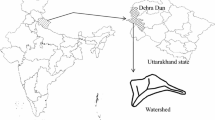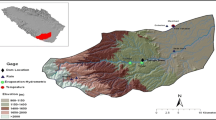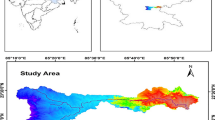Abstract
Land use changes cause changes in the hydrological cycle components and increase or decrease the amount of runoff and erosion in the watershed. Some land use changes become one of the most important problems in some watersheds all over the globe as the case in Ziarat watershed in Golestan province, Iran. Therefore, investigated the impacts of optimal scenario for development of residential areas on soil loss caused by surface runoff and raindrops using the TOPSIS method and WetSpa spatial hydrological distributed model in this study. ArcGIS-based TOPSIS multi-criteria decision making model was used to forman optimal scenario of residential development. WetSpa model inputs consist of digital maps including digital elevation model, land cover and soil texture (with 30 m cell size) and continuous time series of precipitation, evaporation and air temperature over hourly step for 6 years (2007–2013). The accuracy of flow simulations for the calibration period, depending on the Nash-Sutcliffe model efficiency was 67.02% and the suspended sediment concentration and sediment yield were 63.08% and 72.22%, respectively. According to the evaluation criteria considered in this study and using TOPSIS method, 37 hectares of the total watershed area is proper for residential development, but now the residential area of this watershed is more than 141.3 hectares. The amount of soil loss due to raindrops in the whole reference period was 381.54 kg/s and the amount of soil loss due to surface runoff was 227.715 kg/s. After applying the optimal residential development scenario in the WetSpa calibrated model, the amount of soil loss due to surface runoff and raindrops was compared in the two scenarios of current residential status and optimal residential development scenario. The results showed that the amount of soil loss due to surface runoff decreased significantly, but the soil loss caused by raindrops increased. Finally, as the amount of soil loss caused by surface runoff is significantly reduced compared to the soil loss caused by raindrops, the amount of total soil loss decreased.















Similar content being viewed by others
Change history
27 June 2023
This article has been retracted. Please see the Retraction Notice for more detail: https://doi.org/10.1007/s11269-023-03548-3
References
Akter A, Ahmed S (2015) Potentiality of rainwater harvesting for an urban community in Bangladesh. J of Hydro 528:84–93
Alvandi E, Forootan Danesh M, Dahmardeh ghaleno M (2017) Land suitability modelling for urban development using multi-criteria decision-making methods and GIS Case Study: Ziarat Watershed in Golestan Province. Scientific- Research Quarterly of Geographical Data (SEPEHR) 26:169–181. https://doi.org/10.22131/sepehr.2017.25735
Arami H, Alvandi E, Forootan M, Tahmasebipour N, Karimi Sangchini E (2017) Prioritization of watersheds in order to perform administrative measures using fuzzy analytic hierarchy process. J Fac For Istanbul Univ 67(1):13–21
Azizi M, Mohajerani A, Akhavan M (2018) Simulating and Prediction of Flow Using by WetSpa Model in Ziyarat River Basin, Iran. Open J Geo 8:298–312
Bahremand A, Corluy J, Liu Y, De Smedt F, Poórová J, Velcická L (2005) Stream flow simulation by WetSpa model in Hornad river basin, Slovakia. In: van Alphen J, van Beek E, Taal M (eds) Floods, from defence to management. Taylor & francis group, London, pp 415–422
Bahremand A, De Smedt F, Corluy J, Liu YB, Poorova J, Velcicka L, Kunikova E (2007) WetSpa model application for assessing reforestation impacts on floods in Margecany–Hornad Watershed, Slovakia. Water Resour Manag 21(8):27–36
Buraihi FH, Shariff A (2015) Selection of rainwater harvesting sites by using remote sensing and GIS techniques: a case study of Kirkuk, Iraq. J Teknol 76:75–81
Chen FH, Tzeng GH, Chang CC (2015) Evaluating the enhancement of corporate social responsibility websites quality based on a new hybrid MADM model. Int J Inf Technol Decis Mak 14:697–724
Dahmardeh Ghaleno MR (2018) Runoff Simulation using WetSpa Distributed Hydrological Model in Ziarat Watershed of Golestan Province. Iran 6(1):11–20
De Smedt F, Yongbo L, Gebremeskel S (2000) Hydrologic modelling on a catchment scale using GIS and remote sensed land use information. In: Brebbia CA (ed) Risk analysis II. WTI Press, Boston, pp 295–304
Jha MK, Chowdary VM, Kulkarni Y, Mal BC (2014) Rainwater harvesting planning using geospatial techniques and multicriteria decision analysis. Resour Conserv Recycl 83:96–111
Juan SL, Jeronimo TS, Pedro SE, Socorro GC (2013) Geographical Information Systems (GIS) and Multi-Criteria Decision Making (MCDM) methods for the evaluation of solar farms locations: Case study in south-eastern Spain. Renew Sustain Energy Rev 24:544–556
Kabir A, Mahdavi M, Bahremand A, Noora N (2011) Application of a Geographical Information System (GIS) Based Hydrological Model for Flow Prediction in Gorganrood River Basin, Iran. Afr J Agric Res 6:35–45
Kanani M, Salary A, Ghadami M (2011) Zoning of urban development land use based on ecological capability in Mazandaran Province – Iran. Town Country Plan 1(1):28–42
Karimi H, Zeinivand H (2019) Integrating runoff map of a spatially distributed model and thematic layers for identifying potential rainwater harvesting suitability sites using GIS techniques. Geocarto International. https://doi.org/10.1080/10106049.2019.1608590
Karimi H, Zeinivand H, Tahmasebipour N, Haghizadeh A, Miryaghoubzadeh M (2016) Comparison of SRM and WetSpa models efficiency for snowmelt runoff simulation. Environ Earth Sci 75:664
Krois J, Schulte A (2014) GIS-based multi-criteria evaluation to identify potential sites for soil and water conservation techniques in the Ronquillo watershed, northern Peru. Appl Geogr 51:131–142
Liu Z (2001) Sediment transport, Laboratoriet for hydraulic og havne by gning instituttet for vand, jordogmiljøteknik, Aalborg universitet. Lull, H.W., 1964, Ecological and silvicultural aspects, in: Handbook of applied hydrology, VenTe Chow (ed.), 6.1–6.30, McGraw-Hill, New York
Liu YB, De Smedt F (2004) WetSpa extension, a GIS-based hydrologic model for flood prediction and watershed management, documentation and user manual. Vrije Universiteit Brussel (VUB, Brussels), 155 pp
Mahmoud SH, Alazba AA (2014) The potential of in situ rainwater harvesting in arid regions: developing a methodology to identify suitable areas using GIS-based decision support system. Arab J Geosci 8:5167–5179
Mahmoud SH, Tang X (2015) Monitoring prospective sites for rainwater harvesting and stormwater management in the United Kingdom using a GIS-based decision support system. Environ Earth Sci 73(12):8621–8638
Mahmoud SH, Alazba AA, Adamowski J (2015) GIS methods for sustainable stormwater harvesting and storage using remote sensing for land cover data - location assessment. Environ Monit Assess 187(9):598
Mahmoud SH, Adamowski J, Alazba AA, El-Gindy AM (2016) Rainwater harvesting for the management of agricultural droughts in arid and semi-arid regions. Paddy Water Environ 14(1):231–246
Meshram SG, Powar PL, Singh VP (2017) Modelling soil erosion from a watershed using cubic splines. Arab J Geosci 10:155–168
Meshram SG, Alvandi E, Singh VP, Meshram C (2019b) Comparison of AHP and fuzzy AHP models for prioritization of watersheds. Soft Comput 23(24):13615–13625
Meshram SG, Ghorbani MA, Deo RC, Kashani MH, Meshram C, Karimi V (2019a) New Approach for Sediment Yield Forecasting with a Two-Phase Feedforward Neuron Network-Particle Swarm Optimization Model Integrated with the Gravitational Search Algorithm. Water Resour Manag 33(7):2335–2356
Meshram SG, Alvandi E, Meshram C, Kahya E, Al-Quraishi AMF (2020) Application of SAW and TOPSIS in Prioritizing Watersheds. Water Resour Manage. https://doi.org/10.1007/s11269-019-02470-x
Mohammady M, Moradi HR, Zeinivand H, Temme A, Yazdani M (2018) Modelling and assessing the effects of land use changes on runoff generation with the CLUE-s and WetSpa models. Theoret Appl Climatol 133(2):459–471
Moradipour SH (2010) Erosion and suspended sediment yield simulation using spatially distributed WetSpa model, Case study Taleghan watershed in Tehran province. M.Sc. Thesis of watershed management. Gorgan University of agricultural sciences and natural resources. 149p
Nash JE, Sutcliffe JV (1970) River flow forecasting through conceptual models part I - A discussion of principles. J Hydrol 10(3):282–290
Shi ZH, Huang XD, Ai L, Fang NF, Wu GL (2014) Quantitative analysis of factors controlling sediment yield in mountainous watersheds. Geomorphology 226:193–201
Tavakoli M, De Smedt F (2013) Validation of soil moisture simulation with a distributed hydrologic model (WetSpa). Environ Earth Sci 69(3):739–747
Yang J, Liu Y, Yang W, Chen Y (2012) Multi-Objective Sensitivity Analysis of a Fully Distributed Hydrologic Model WetSpa. Water Resour Manag 26(1):109–128
Zavadskas EK, Turskis Z, Kildienė S (2014) State of art surveys of overviews on MCDM/MADM. Technol Econ Dev Econ 20:165–179
Zeinivand H (2009) Development of spatially distributed hydrological WetSpa modules for snowmelt, soil erosion, and sediment transport [PhD Thesis]. Brussels: Vrije Universiteit Brussel 238 pp
Zeinivand H, De Smedt F (2009a) Spatially distributed modelling of soil erosion and sediment transport at watershed scale. In: Starrett S, editor. Proceedings World Environmental & Water Resources Congress; May 17–21. Kansas City, MO: American Society of Civil Engineers; p 6499–6508
Zeinivand H, De Smedt F (2009b) Hydrological Modelling of Snow Accumulation and Melting on River Basin Scale. Water Resour Manag 23(11):2271–2287
Zeinivand H, De Smedt F (2010) Prediction of snowmelt floods with a distributed hydrological model using a physical snow mass and energy balance approach. Nat Hazards J 54:451–468
Zeinivand H, Nourmohammadi F (2017) Application of partial least squares regression and WetSpa model to determine factors controlling sediment yield in Chardavol watershed, Iran. Geocarto Int 32(4):386–400
Author information
Authors and Affiliations
Corresponding authors
Ethics declarations
Conflict of Interest
The authors declare that they have no conflict of interest.
Additional information
Publisher's Note
Springer Nature remains neutral with regard to jurisdictional claims in published maps and institutional affiliations.
This article has been retracted. Please see the retraction notice for more detail: https://doi.org/10.1007/s11269-023-03548-3"
Rights and permissions
Springer Nature or its licensor (e.g. a society or other partner) holds exclusive rights to this article under a publishing agreement with the author(s) or other rightsholder(s); author self-archiving of the accepted manuscript version of this article is solely governed by the terms of such publishing agreement and applicable law.
About this article
Cite this article
Forootan Danesh, M., Dahmardeh Ghaleno, M.R., Alvandi, E. et al. RETRACTED ARTICLE: Predicting the Impacts of Optimal Residential Development Scenario on Soil Loss Caused by Surface Runoff and Raindrops Using TOPSIS and WetSpa Models. Water Resour Manage 34, 3257–3277 (2020). https://doi.org/10.1007/s11269-020-02611-7
Received:
Accepted:
Published:
Issue Date:
DOI: https://doi.org/10.1007/s11269-020-02611-7




